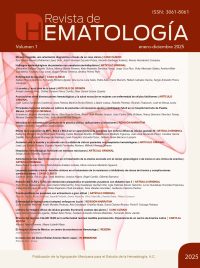5q deletion syndrome.
Rev Hematol Mex. 2020 enero-marzo;21(1):56-60. https://doi.org/10.24245/rev_hematol.v21i1.3554
David Esteban Arias-Mira
Unidad de Cuidados Intensivos, IPS Universitaria, Universidad de Antioquia, Colombia.
Resumen
ANTECEDENTES: El síndrome de deleción del 5q es la anomalía citogenética más frecuente y de mejor pronóstico en los pacientes con síndromes mielodisplásicos. Se caracteriza por anemia macrocítica, trombocitosis y megacariocitos hipolobulados, incluyendo un conteo menor de 1% de blastos en sangre periférica y menor de 5% en médula ósea.
CASO CLÍNICO: Paciente femenina de 83 años, quien consultó al servicio de urgencias por hallazgo de hemoglobina en 5.5 g/dL durante exámenes de rutina, por lo que requirió terapia transfusional. El estudio de hibridación fluorescente in situ documentó positividad de 46% para la deleción del 5q31, por lo que se inició tratamiento con eritropoyetina 6000 UI cada 7 días y lenalidomida 10 mg/día durante 21 días cada mes; a los seis meses de seguimiento se evidenció respuesta clínica significativa porque no requirió soporte transfusional.
CONCLUSIONES: El diagnóstico temprano del síndrome de deleción del 5q por medio de hibridación fluorescente in situ (FISH) facilita el tratamiento oportuno con lenalidomida y eritropoyetina que, a su vez, disminuye el requerimiento transfusional de forma notoria y sus complicaciones por la sobrecarga de hierro, al igual que el riesgo de progresión a leucemia mieloide aguda.
PALABRAS CLAVE: Síndrome mielodisplásico; lenalidomida; leucemia mieloide aguda.
Abstract
BACKGROUND: The 5q deletion syndrome is the most frequent cytogenetic anomaly with the best prognosis in patients with myelodysplastic syndromes. It is characterized by macrocytic anemia, thrombocytosis and hypolobulated megakaryocytes, including a count lesser than 1% of blasts in peripheral blood and lesser than 5% in bone marrow.
CLINICAL CASE: A 83-year-old female patient, who consulted the emergency department for finding hemoglobin at 5.5 g/dL during routine examinations, and therefore required transfusion therapy. The fluorescent in situ hybridization study documented 46% positivity for the 5q31 deletion, so treatment with erythropoietin 6000 IU was started every 7 days and lenalidomide 10 mg/day for 21 days every month. At six months of follow-up, a significant clinical response was evident because patient did not require transfusion support.
CONCLUSIONS: Early diagnosis of 5q deletion syndrome by means of in situ fluorescent hybridization (FISH) facilitates timely treatment with lenalidomide and erythropoietin, which in turn reduces the transfusion requirement significantly and its complications due to iron overload, as well as the risk of progression to acute myeloid leukemia.
KEYWORDS: Myelodysplastic syndrome; Lenalidomide; Acute myeloid leukemia.

